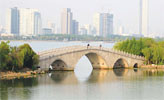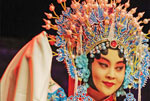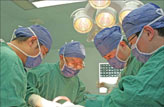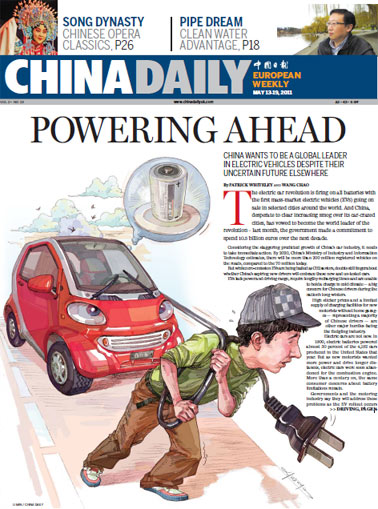Island getaway
Updated: 2011-05-13 11:27
By Jules Quartly (China Daily European Weekly)
 |
|
Taipei 101 towers over the capital's skyline and from 2004 was the world's tallest building until Burj Khalifa was opened in Dubai. Provided to China Daily |
From the heights of Taipei 101 to the depths of sulfurous hot spring baths, the capital of Taiwan province has a lot to offer
A weekend in Taipei can be made up of a rapid succession of attractions wrapped up in a subtropical garden of delights. The city's compact size and convenient transport options allow visitors to see and do more in 48 hours than they could in a week elsewhere. The capital of Taiwan province is a concentrate of the mainland experience, slightly more traditional, with hints of Japanese, European and Aboriginal influences - and a style all its own. Here are five must-see sites and experiences.
 |
1. Taipei 101
Head for Taipei 101 (Taipei City Hall MRT), which looks like a bamboo reed poking into the sky. You really can't miss it. Until recently it used to be the world's tallest building, and you are recommended to go straight to the top for a truly panoramic view of the city.
On a clear day, the city shimmers and merges into the mountain ranges that struggle to contain it. The observation tower has maps of the city to reference, so it is a simple exercise to identify all the locations you plan to visit - a bit like looking at a satellite map.
When you've seen enough it's probably time for tea or coffee and a quick ride back down on the supercharged elevators, the world's fastest.
In the mall there are plenty of choices for light refreshment, before browsing the elegant lifestyle avenues, city squares and designer walks. High-end shopping is the order of the morning here, so come prepared with a credit card if you are in the mood to spend.
2. Markets
For a completely different shopping experience, head to the nearby textile market of Wufenpu (Houshanpi MRT).
Named after five mainland settlers who bought "five parcels of land", it's a great place to polish your bargaining skills.
Originally, a wholesaler's market, this is where the smart young money does its shopping for clothes and accessories. It's crammed with bargain hunters, but has a laid-back atmosphere that is typically Taiwanese.
Lunchtime. As you might expect from a city with one of the highest population densities in the world, Taipei is packed with restaurants and good places to eat are on every street, although dining at a rickety table on plastic stools in a market is a must.
Savor beef noodle soup with cilantro, hot pot (known as shabu shabu) with shacha sauce, dumplings at Din Tai Fung, dim sum at a number of hotels, Hakka or Kejia food, fish fare (Taiwan's an island) and cuisine based on dishes from all over China - but generally with a lighter touch, less salt and oil.
The Shihlin Night Market (Jiantan MRT) - one of the world's best in my humble opinion - is a great place to recharge on snacks and a juice drink, or simply enjoy the carnival spirit.
You will have to negotiate huge crowds, especially on the weekend, but try following your nose to Cicheng Temple, where you will find vendors selling smelly tofu, which you should try, if only to say you have. It's an unforgettable experience.
Your head should be swimming (after the tofu) and your feet aching by this point, so it's time to unwind in Beitou (Xin Beitou MRT).
3. Hot baths
One of the fortunate things about living in an active earthquake zone is sulfurous hot spring baths. Their health benefits were largely ignored before the Japanese invaded (1895-1945) and demonstrated they were pleasant to bathe in.
There are so many 24-hour hot spring hotels you can walk around and take your pick, and they range from five stars to bathhouse cheap.
It's late and you may be considering an early start next day, but for those of you revivified by the hot spring waters, head back downtown to find a lounge bar. It won't be difficult, the city is famous for them. My choices are Fifi's W Bar, Room 18, The Bed and possibly Champagne Bar.
Nightlife carries on till early morning most nights. If you fancy a late night snack before bed, try one of the all-night congee restaurants on Fuxing South Road.
4. Taipei Palace Museum
If you are champing at the bit for some highbrow culture, there's no better place in the world for immersion in Chinese antiquities than the Taipei Palace Museum (Shilin MRT and bus R30).
It has a permanent collection of 677,687 Chinese artifacts and works of art, covering 8,000 years of history.
There's always something going on here as exhibitions come and go, but the real meat is in the permanent collection and it's certain you will be blown away by something, whether it's a painting by Zhang Daqian - China's Picasso - or a small piece of jadeite cabbage with insects crawling over it.
Looking around will take at least a morning and you are also recommended to get lunch or tea at one of the two cafes, while the elegant fourth floor Sanxitang Teahouse is well worth spending some downtime in.
5. Bicycle tour
After traipsing around the museum, get some wind in your sails with a bicycle ride along the riverside in Wanhua, one of the earliest settling points for seafaring traders in Taipei.
It's a 20-minute walk from Shuanglian MRT (Exit 2) to Dihua Street, but you won't be wasting your time as there are a number of stores selling traditional Chinese goods, such as dried foods, medicines and incense, in addition to the scenic value of Japanese and Qing Dynasty (1644-1911) era architecture, much of which has been preserved.
Nearby is Dadaocheng Port (marked by a full-scale model of a Qing boat), which is where you can hire a bicycle on the weekend and explore Danshui River. It's a green highway whether you head left or right, dotted with parks and pagodas and abundant bird life.
Dusk is the time to check in your bike and explore Ximending, where trends are set and tattoos inked. It's a great setting for connoisseurs of Japanese culture products and impromptu concerts by Mandopop demigods, especially on Saturday and Sunday afternoons.
E-paper

Green works
Wuxi becomes 'test case' for facing country's environmental challenges
The global rise of Chinese brands
China-EU trade on solid ground
ZTE banks on innovation
Specials

The song dynasty
There are MORE THAN 300 types of Chinese operas but two POPULAR varieties are major standouts

Cut above the rest
One of the world's oldest surgeons has performed more than 14,000 operations

From the ground up
Architect of Guangzhou Opera House has many projects under way, including 2012 Olympics.
